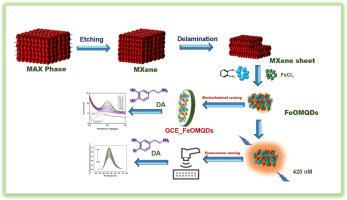Iron and nitrogen co-doped MXene quantum dots: A novel dual-mode electrochemical and fluorescence sensor for dopamine detection
IF 6.3
3区 工程技术
Q1 ENGINEERING, CHEMICAL
Journal of the Taiwan Institute of Chemical Engineers
Pub Date : 2025-09-27
DOI:10.1016/j.jtice.2025.106421
引用次数: 0
Abstract
Background
MXene quantum dots (MQDs) possess excellent conductivity, abundant active sites, and unique optical properties, yet their metal/heteroatom-modified sensing applications remain underexplored. Here, we report Fe- and N-co-doped MXene quantum dots (FeOMQDs) for the detection of dopamine (DA).
Methods
FeOMQDs were synthesized via a one-step hydrothermal process using MXene sheets, FeCl₃, and o-phenylenediamine, and characterized by FTIR, TEM, and XPS. Their fluorescence and electrochemical properties were exploited for DA sensing.
Significant Findings
The fluorescence sensing mechanism is governed by DA-induced quenching of FeOMQDs photoluminescence through metal–analyte complexation. The platform exhibited a linear range of 1–10 nM with a detection limit of 0.56 nM. For electrochemical analysis, FeOMQDs were immobilized on glassy carbon electrodes (GCE) and screen-printed electrodes (SPE), followed by evaluation via cyclic voltammetry (CV) and differential pulse voltammetry (DPV). Enhanced electrocatalytic activity toward DA oxidation was observed, attributed to the synergistic interactions between Fe centers and the MXene matrix. The FeOMQDs–GCE demonstrated a linear range of 2–20 nM with detection limits of 1.8 nM (CV) and 1.09 nM (DPV), along with an extended linear range of 40–1000 nM in CV studies. The probes showed excellent reproducibility, stability, and selectivity, with reliable recovery in human serum, confirming their promise for practical bioanalytical applications.

铁氮共掺杂MXene量子点:用于多巴胺检测的新型双模电化学和荧光传感器
mxene量子点(mqd)具有优异的导电性、丰富的活性位点和独特的光学性质,但其金属/杂原子修饰的传感应用仍未得到充分的探索。在这里,我们报道了铁和n共掺杂的MXene量子点(FeOMQDs)用于检测多巴胺(DA)。方法以MXene片、FeCl₃和邻苯二胺为原料,采用一步水热法合成feomqds,并用FTIR、TEM和XPS对其进行表征。利用它们的荧光和电化学性质进行DA传感。重要发现荧光传感机制是由da诱导FeOMQDs通过金属分析物络合猝灭光控制的。该平台线性范围为1 ~ 10 nM,检出限为0.56 nM。为了进行电化学分析,将FeOMQDs固定在玻碳电极(GCE)和丝网印刷电极(SPE)上,然后通过循环伏安法(CV)和差分脉冲伏安法(DPV)进行评价。由于Fe中心与MXene基体之间的协同作用,电催化活性增强。FeOMQDs-GCE的线性范围为2 ~ 20 nM,检出限为1.8 nM (CV)和1.09 nM (DPV),在CV研究中线性范围扩展为40 ~ 1000 nM。该探针具有良好的重复性、稳定性和选择性,在人血清中具有可靠的回收率,证实了它们在实际生物分析应用中的前景。
本文章由计算机程序翻译,如有差异,请以英文原文为准。
求助全文
约1分钟内获得全文
求助全文
来源期刊
CiteScore
9.10
自引率
14.00%
发文量
362
审稿时长
35 days
期刊介绍:
Journal of the Taiwan Institute of Chemical Engineers (formerly known as Journal of the Chinese Institute of Chemical Engineers) publishes original works, from fundamental principles to practical applications, in the broad field of chemical engineering with special focus on three aspects: Chemical and Biomolecular Science and Technology, Energy and Environmental Science and Technology, and Materials Science and Technology. Authors should choose for their manuscript an appropriate aspect section and a few related classifications when submitting to the journal online.

 求助内容:
求助内容: 应助结果提醒方式:
应助结果提醒方式:


